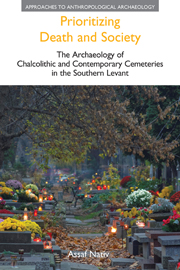 Prioritizing Death and Society
Prioritizing Death and Society from Part III - Contemporary cemeteries
The application of archaeological methods to present-day contexts and to the recent past has been straddling the side lines of the discipline for approximately five decades now (Gould & Schiffer 1981; Shanks ' Tilley 1992: 172—240; Bailey et al. 2009; Harrison & Schofield 2009; González-Ruibal & Hernando 2010). Its roots are to be found with the positivist movement of processual archaeology that encouraged archaeologists to explore the material culture of contemporary societies and their behavioural correlates (Trigger 2006). It was, however, most likely the call of this movement to discover universal rules underlying human culture that instigated the first calls to abandon the past as a necessary definition of the discipline.
In his formulation of a manifesto for modern material culture studies, Rathje (1979, 1981) cited four potential contributions such endeavours are likely to have for archaeology:
teaching archaeological principles;
testing archaeological principles;
recording the archaeology of today;
relating our own society and culture to those of the past.
It is remarkable that Rathje did not suggest contemporary material culture studies as a field that may have a great deal to offer the understanding of the present per se. Shanks and Tilley (1992: 172—3) rightly noted that, anchored as they were in functionalist and empiricist perspectives of processual archaeology, early studies of present-day material culture tended to produce insights of limited significance, failing to acknowledge its relevance for the understanding of the present.
To save this book to your Kindle, first ensure [email protected] is added to your Approved Personal Document E-mail List under your Personal Document Settings on the Manage Your Content and Devices page of your Amazon account. Then enter the ‘name’ part of your Kindle email address below. Find out more about saving to your Kindle.
Note you can select to save to either the @free.kindle.com or @kindle.com variations. ‘@free.kindle.com’ emails are free but can only be saved to your device when it is connected to wi-fi. ‘@kindle.com’ emails can be delivered even when you are not connected to wi-fi, but note that service fees apply.
Find out more about the Kindle Personal Document Service.
To save content items to your account, please confirm that you agree to abide by our usage policies. If this is the first time you use this feature, you will be asked to authorise Cambridge Core to connect with your account. Find out more about saving content to Dropbox.
To save content items to your account, please confirm that you agree to abide by our usage policies. If this is the first time you use this feature, you will be asked to authorise Cambridge Core to connect with your account. Find out more about saving content to Google Drive.